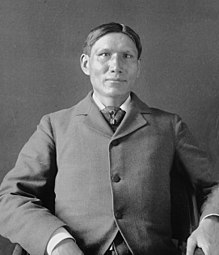
Back قبيلة داكوتا Arabic Дакота Byelorussian Nació Dakota Catalan Dakota (Volk) German Dakotoj Esperanto Pueblo dakota Spanish Dakotat Finnish Dakotas French Dakota (folk) Frisian Pobo dakota Galician
 Charles Alex Eastman (1858–1939), physician, author, and co-founder of the Boy Scouts of America | |
| Total population | |
|---|---|
| 20,460 (2010)[1] | |
| Regions with significant populations | |
| Languages | |
| Dakota,[1] English | |
| Religion | |
| Christianity (incl. syncretistic forms), Native American religions, Native American Church, Wocekiye | |
| Related ethnic groups | |
| Lakota, Assiniboine, Stoney (Nakota), and other Sioux |
| Dakota "ally / friend" | |
|---|---|
| People | Dakȟóta Oyáte |
| Language | Dakȟótiyapi Wíyutȟapi |
| Country | Dakȟóta Makóce, Očhéthi Šakówiŋ |
The Dakota (pronounced [daˈkˣota], Dakota: Dakȟóta or Dakhóta) are a Native American tribe and First Nations band government in North America. They compose two of the three main subcultures of the Sioux people, and are typically divided into the Eastern Dakota and the Western Dakota.
The four bands of Eastern Dakota are the Bdewákaŋthuŋwaŋ, Waȟpéthuŋwaŋ, Waȟpékhute, and Sisíthuŋwaŋ and are sometimes referred to as the Santee (Isáŋyathi or Isáŋ-athi; 'knife' + 'encampment', 'dwells at the place of knife flint'), who reside in the eastern Dakotas, central Minnesota and northern Iowa. They have federally recognized tribes established in several places.
The Western Dakota are the Yankton, and the Yanktonai (Iháŋktȟuŋwaŋ and Iháŋktȟuŋwaŋna; "Village-at-the-end" and "Little village-at-the-end"), who reside in the Upper Missouri River area. The Yankton-Yanktonai are collectively also referred to by the endonym Wičhíyena ('Those Who Speak Like Men'). They also have distinct federally recognized tribes. In the past the Western Dakota have been erroneously classified as Nakota, who are located in Montana and across the border in Canada, where they are known as Stoney.[2]